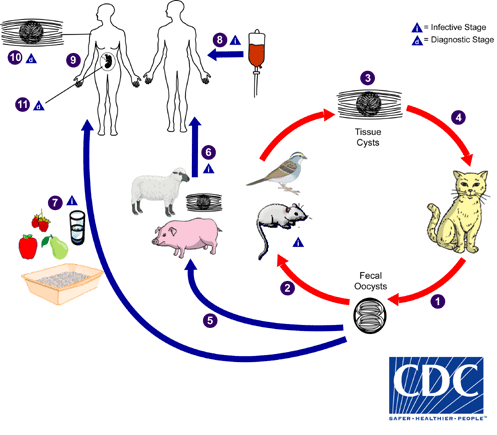Introduction to Diagnostic Medical Parasitology
Essentials
Toxoplasmosis is produced by an intracellular sporozoan parasite for which cats are the only definitive host. Toxoplasma gondii infects humans and many animals as intermediate hosts causing systemic disease with lymphadenopathy. It may be transplacentally transmitted to the foetus causing congenital toxoplasmosis.



Epidemiology
- Distribution is worldwide except in extremely cold and dry areas
- Distribution is dependent on cats, the only final host
- Infection in humans is common and permanent
- Humans are infected by the ingestion of cysts (undercooked or raw meat) or by ingestion of oocysts (soil contaminated with cat faeces eaten by children)
- No person-to-person transmission (except in utero)
Pathology
- Acute infection: sporozoites from oocysts or bradyzoites from ingested tissue cysts become tachyzoites which invade the intestinal mucosa. Via lymphatic vessels, they infect the regional lymph node and are then distributed via blood to many organs. Tachyzoites can invade all nucleated cells. Acute infection can be asymptomatic or is a febrile disease with a variety of symptoms. In most infected hosts, an effective immune response is built up.
- Persisting chronic infection: bradyzoites persist in tissue cysts (e.g. in the brain, muscle) for life without causing disease. In AIDS patients or after immunosuppressive treatment, recrudescent infections may result: multiplying tachyzoites may produce multiple necrotic lesions in the brain or in other tissues. This results in all forms of systemic disease which may be fatal!
Clinical Findings
- Incubation period: 5–23 days
- Primary toxoplasmosis is a acute febrile multi-system disease with multiple varying symptoms
- Congenital toxoplasmosis: primary infection during early pregnancy may result in abortion, stillbirth or prematurity. The foetal infection can lead to various clinical findings (e.g. hydrocephalus) or even to death.
Diagnosis
Diagnostic methods
Parasitological diagnosis
Oocysts are only found in cats and other felids! Therefore serological methods are of great importance. The parasite (cysts or trophozoites) may be found in tissue biopsies. Free tachyzoites may be found in bronchoalveolar lavage samples.
Molecular diagnosis
Nested PCR and recently also real-time PCR are used to detect Toxoplasma in cerebrospinal fluid or tissue samples
Antigen detection
Only few reports on the detection of circulating antigens during acute infection
Antibody detection
Serology is the traditional method to detect Toxoplasma infections. Specific IgM antibodies are the most frequently used serological marker for a recent infection. However, false-positive results and the persistence of IgM antibodies complicate the interpretation. As an alternative approach, the measurement of the avidity of IgG antibodies against T. gondii by the titration method in patients with detectable IgM antibodies can efficiently define the stage of infection.
Diagnostic strategies
In-depth serological investigations are the cornerstone of all diagnostic approaches!
Prevention and control
- Pregnant women should be carefully informed about risks and prevention: avoid contact with cats, eat no raw meat, wash hands thoroughly before eating or after contact with cats, soil etc.
- Patients with AIDS should receive prophylactic treatment throughout life.